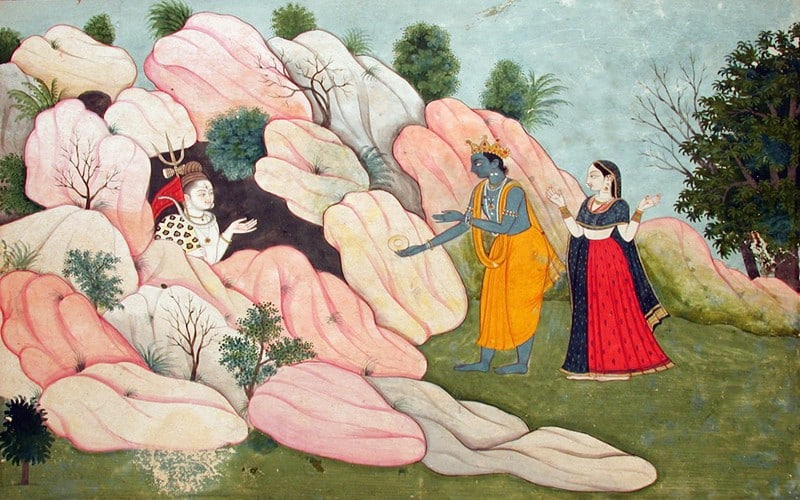In the multidimensional pantheon of Hindu Goddesses, Goddess Rati emerges as an emblem of love and desire. Her essence, deeply interwoven with the human experience of passion, transcends mere physicality, embodying the emotional and spiritual dimensions of love.
As the consort of Kamadeva, the God of love, Rati’s role in the pantheon is not just of a deity but a harbinger of the complexities and nuances of love and relationships. Her narratives, steeped in ancient texts, offer a window into the soul’s yearning for connection. The Rigveda, though not explicitly mentioning Rati, alludes to the cosmic play of love and desire, a theme that finds its embodiment in her.
Goddess Rati in the Hindu Pantheon
Devi Rati is the Goddess of love, sexuality, desire, and pleasure in Hinduism. She is often depicted alongside her husband Kamadeva, the God of Love. The sexual union of Rati and Kamadeva is symbolic of the blossoming of conjugal love for all couples. Kamadeva’s love arrows that can arouse and incite even the most austere of sensibilities are symbolic of the immense significance of sexual love in sustaining the universe.
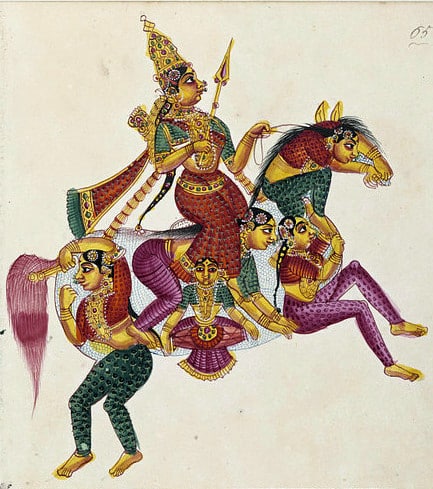
At a deeper level, Rati and Kamadeva’s divine union and their playful repartee also symbolize the blurred boundaries between sexuality and divinity in Hinduism. The role played by the sexual union in sustaining all creation is never downplayed in Hinduism, rather it is celebrated. That is why Devi Rati represents a higher plane of divine love as well, connected to the essence of Shiva and Shakti, and not just carnal love.
Devi Rati is believed to be the daughter of Prajapati Daksha. She is often referred to as the Venus of the Hindus.
In the Puranas, Devi Rati’s tales weave through the cosmic fabric, influencing Gods and mortals alike. Her interactions with other deities, particularly with her consort Kamadeva, highlight her role in the cosmic balance of emotions. Rati, in her essence, represents the primal force of love that binds the universe, a concept echoed in the Upanishads where the fundamental interconnectedness of all beings is a recurring theme. Her presence in the pantheon is a testament to the ancient Hindu understanding of love as a vital, divine force.
Love Goddesses from other Pantheons
Aphrodite, from Greek mythology, is renowned for her irresistible charm and is often depicted as the embodiment of beauty and romantic desire. Freyja, from Norse mythology, shares similarities with both, being a goddess of love, beauty, and fertility. While Aphrodite and Freyja are often associated with the physical and sovereign aspects of love and attraction, Devi Rati’s narrative places a significant emphasis on the spiritual and emotional dimensions of love.
Another similarity is that just like Rati is a popular girl name for Hindus’, Freyja is in use today as a Norse female name with Viking Age roots.
Symbolic Significance of Rati
Rati is a Sanskrit word that is derived from the root “ram” which means “to enjoy” or “delight in”. That is why Devi Rati is symbolic of the delightful and pleasure-giving aspect of the act of lovemaking.
However, Goddess Rati is always depicted along with her husband Kamadeva in the context of sexual love. Therefore, the sexual love and pleasure Devi Rati signifies is deeply connected to conjugal or marital love. Many write-ups on Devi Rati tend to over-focus on the “sexual love” aspect and call Devi Rati a Goddess of Lust. This frivolizes the deep love and devotion of this Goddess for her husband Kamadeva who also covered herself in ashes and practiced deep penance once lord Shiva took his life away in a fit of rage. Devi Rati surely symbolizes the playful and amorous aspect of love but it would be wrong to call her a Goddess of Lust.
Goddess Rati, in her divine form, is often depicted as the epitome of beauty and allure, a symbol of the joy, fulfillment, and profound beauty that love brings to life. Her role as the consort of Kamadeva, the God of love, accentuates her significance in the celestial hierarchy. Together, they represent the full spectrum of romantic and passionate love. Their union is not merely a conjunction of two deities, but a symbolic representation of the harmonious balance between desire and affection, passion and devotion. The Skanda Purana narrates how their love transcends the physical realm, touching the soul and leading to spiritual awakening.
Devi Rati Origins

The story of Devi Rati’s birth is discussed in various Puranas. According to the Kalika Purana, Lord Brahma produced Kamadeva, or the God of Love after he created the ten Prajapatis. Kamadeva was given the task of spreading love throughout the universe by shooting his divine love arrows. Daksh Prajapati was given the responsibility of getting Kamadeva married.
According to legend, as soon as Kamadeva is created, he starts shooting his love arrows toward Brahma and the ten Prajapatis. As a result, they all get incestuously attracted to Brahma’s daughter Sandhya. Lord Shiva, who is passing by, observes them in this state and laughs. This embarrasses them and the Prajapatis start sweating. Thereby emerges a woman of celestial beauty from the perspiration of Daksh Prajapati. She is none other than Goddess Rati.
Thus, Devi Rati becomes the wife of Kamadeva. However, lord Brahma also curses Kamadeva that he will be charred into ashes by lord Shiva in the future. Kamadeva pleads for forgiveness and thus, Brahma promises that he will be reborn.
According to Brahma Vaivarta Purana, Devi Rati is a reincarnation of lord Brahma’s daughter Sandhya who commits suicide because her own father lusted after her under the influence of Kamadeva’s love arrows. But Lord Vishnu revives her, gives her the name Rati, and gets her married to Kamadeva. According to another version of the same story, it is Sandhya who gets reborn as Rati due to the perspiration of Daksh Prajapati. Some scriptures also mention lord Shiva as the father of Rati.
Goddess Rati Representation
In the realm of Hindu art and scripture, Devi Rati is portrayed with grace and elegance, often seen with Kamadeva. Artistic depictions show her with a radiant complexion, a symbol of her inner light and the life-giving force of love. She is frequently adorned with flowers and jewels, signifying the beauty and richness of love.
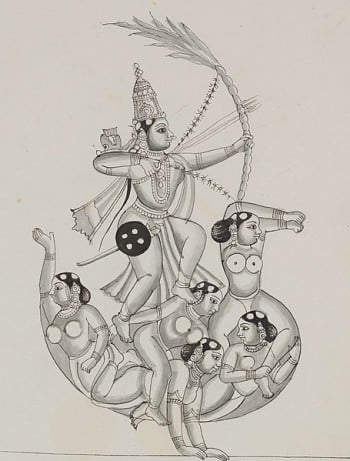
According to legend, lord Kamadeva was pierced by Devi Rati’s love arrows upon catching a glimpse of her. She is portrayed as a woman of exceptional divine beauty with a striking smile, huge expressive eyes, luscious tresses, plum breasts, a tiny waist, voluptuous thighs, and glowing skin.
Devi Rati is often depicted with her husband, consort, and lover Kamadeva in Indian temple scriptures and art. Rati and Kamadeva are depicted as messengers of love of sorts whose mission is to bedazzle the world with the light of love through their divine love arrows. They often follow instructions of other Gods and accordingly target individuals with their love arrows.
Goddess Rati is often depicted riding a parrot along with her husband Kamadeva. Sometimes, she is also portrayed riding a horse like a queen. This representation depicts her Kshatriya ( the warrior clan ) origins as the daughter of Daksha Prajapati.
In scriptures, her narratives are woven with themes of devotion, longing, and the transformative power of love, offering profound insights into the nature of human emotions. The Mahabharata, for instance, describes her as a Goddess who evokes desire yet transcends its physical boundaries, embodying a love that is both ethereal and eternal.
Rati’s Mythological Tales and Legends
The mythological tales of Goddess Rati are rich with symbolism and emotion. One of the most poignant stories is her unwavering devotion to Kamadeva after his incineration by Lord Shiva’s third eye. Her profound grief and steadfast love eventually lead to his resurrection, symbolizing the enduring power of love over destruction. This narrative, found in the Puranas, resonates with the theme of love’s triumph over adversity, a concept deeply rooted in Hindu philosophy.
According to legend, lord Shiva went into deep sorrow after the death of his first wife Sati. Seeing this, demon Tharkasura wreaked havoc in the universe. He had been given a boon that he could be killed only by the son of lord Shiva. Seeing lord Shiva’s state, he thought how would the lord ever have a son? Seeing Tharkasur’s ways, Kamadeva is instructed by other Gods to go to lord Shiva along with Devi Rati and invoke desire in his ascetic being through their love arrows.
Kamadeva and Rati went to Mount Kailash as instructed. The love arrows had their effect as lord Shiva came out of his meditative state and fell in love with Parvati. This deeply angered and disturbed him though and he charred Kamadeva with his third eye.
Goddess Rati’s penance and Kamadeva’s rebirth
According to legend, Devi Rati went crazy with grief after the death of her husband Kamadeva. She smeared herself with Kamadeva’s ashes and practiced severe penance.
Goddess Rati appealed to Devi Parvati to persuade lord Shiva to return her husband. She thus received an assurance from Devi Parvati that Kamadeva would be reborn as Pradyumna, the son of lord Krishna and Rukmini.
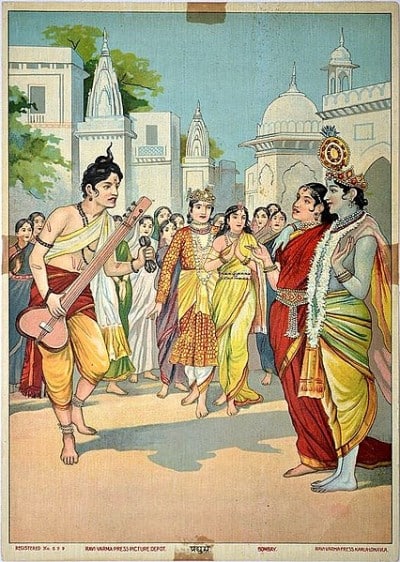
Devi Rati thus proceeded to the demon Sambara’s kitchen in the form of Mayawati, a maid, and waited for her spouse’s arrival in the demon’s house. Devi Parvati has told Rati that she would meet her husband at demon Sambara’s house. Sambara already knew that the child of Krishna and Rukmini would be responsible for his death. He thus abducted the child and threw him into the vast ocean. The child was however gulped down by a fish. As destiny had it, teh fishermen took the fish to Sambara’s kitchen after catching it.
The child was discovered by Mayawati when the fish was sliced. She chose to raise the child and nurture him like a mother. At that time, Mayawati did not know that this child was the reincarnation of Kamadeva. At some point, Narad Muni told her that the child being raised by her was lord Kamadeva, her husband and she was Devi rati, the Goddess of Love. This placed Mayawati in a whirlpool of conflicting feelings as she started getting attracted towards her husband as he starting getting out of childhood and embraced adulthood.
Rati and Kamadeva Reunion
Kamadeva initially felt awkward and rejected Rati’s advances, thinking why is this older woman who raised me up looking at me romantically. It was then that Devi Rati communicated to him the truth of their previous births.
She told him that he was the son of lord Krishna and Rukmini. As Mayawati, Devi Rati taught Pradyumna the art of war and he thus slayed the demon Sambara.
Legend has it that after the end of the demon, Pradyumna returned to Dwarka with his wife Mayawati in their original forms ( Rati and Kamadeva ). It is said they lived happily as a couple for 63,000 years!
Rati’s Influence on the Gods and Mortals
Rati’s influence extends beyond the celestial realms, touching the lives of mortals. Her interventions in the affairs of Gods and humans alike are often driven by her deep understanding of the heart’s desires.
In several tales, she is seen guiding and aiding lovers, helping them overcome obstacles and fulfill their destinies. Her role in these narratives is not just as a facilitator of romantic unions, but as a guardian of love’s purity and sanctity. The Padma Purana, for example, recounts tales where Rati’s intervention alters the course of love, weaving the human experience with the divine.
Rati in Spiritual and Cultural Context
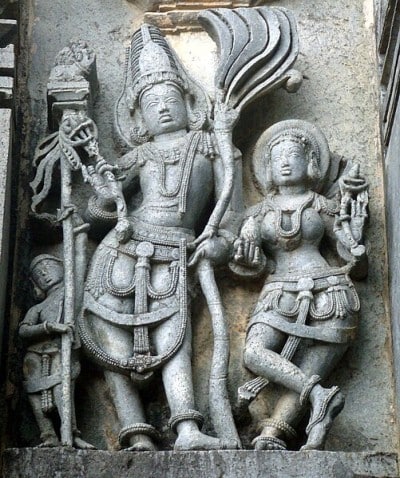
The tales of Goddess Rati are not mere mythological entertainments; they carry profound spiritual and philosophical undertones. Her narratives often highlight the duality of love – its capacity to bring both joy and sorrow, creation and destruction.
In Hindu philosophy, Rati’s tales are seen as allegories for the human soul’s journey towards spiritual enlightenment, where love acts as both the path and the destination. The Bhagavad Gita, while not directly referencing Rati, speaks to the concept of divine love as a force that transcends the physical and elevates the spirit. Rati, in her mythological roles, exemplifies this idea, portraying love as a transformative power that can lead to spiritual awakening and liberation.
Love is not all easy and rosy, as Goddess Rati’s story tells us. She is an epitome of supreme love and marital bliss as she goes around the universe with her husband Kamadeva, enchanting everyone with the power of their love arrows. But even the Goddess of Love cannot undo the clock of destiny. Her husband dies due to lord Shiva’s wrath changing Rati’s course of life. The Goddess of Love practices severe penance and has to act as a foster mother to her own husband to bring him back to his life.
Devi Rati thus is not only the Goddess of love in the sense of physical love and pleasure. She embodies the deep and sublime love that exists betwen a husband and a wife. It’s precisely because of her pativrata (devotion to husband ) nature that Goddess Rati gets back her husband in his next birth.
Cultural and literary impact of Goddess Rati
The cultural impact of Goddess Rati is evident in various aspects of Indian art, literature, and festivals. Her tales have inspired countless works of poetry, drama, and dance, celebrating the many facets of love. Emotions and stories associated with Rati are often portrayed through intricate movements and expressions, capturing the essence of her divine love.
In literature, Rati’s influence can be seen in the works of ancient poets like Kalidasa, who often drew upon her myths to illustrate the beauty and complexity of love. In festivals like Holi, the playful and loving aspects of Rati are celebrated, reflecting her enduring presence in the cultural fabric of India.
Goddess Rati is also invoked in the Shringaar Ras ( romantic ) tradition of poetry in Indian literature. One comes across many poems written in old dialects of Hindi like the Braj Bhasha where the beauty of the nayika ( beloved ) is described by comparing her attributes and characteristics to the divine beauty of Rati.
Goddess Rati and Kamadeva’s story is also a source of inspiration for many ancient Hindu texts on sexual love, the most notable being Kamasutra, an ancient Indian Sanskrit text on eroticism, sexual love, and emotional fulfilment written by Vatsyayana. Another popular book that takes inspiration from Devi Rati is Rati Rahasya, a literally treatise on sexuality written by Pandit Kokkoka in the 11th or the 12th century.
Devotion and Worship of Goddess Rati
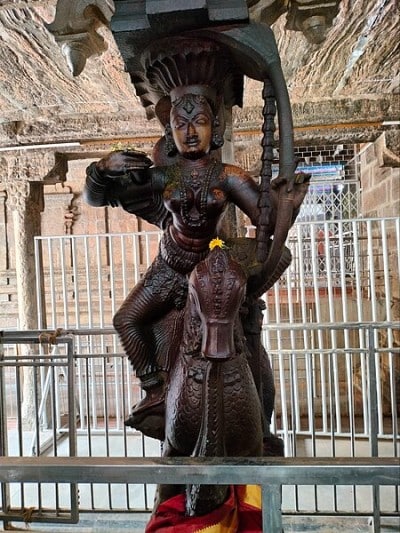
The worship of Goddess Rati, though not as prevalent as that of other deities in the Hindu pantheon, holds a special place in the hearts of her devotees. Rituals dedicated to Rati are imbued with symbolism and are often intertwined with the worship of Kamadeva.
During certain festivals, such as Holi, the festival of colors, and Vasant Panchami, the arrival of spring, Rati is venerated as the Goddess of love and passion. Devotees offer prayers, flowers, and symbolic offerings, seeking her blessings for fulfilling and harmonious relationships.
In some traditions, Devi Rati is also invoked in marriage ceremonies and rituals related to love and companionship, where couples seek her blessings for a life filled with love, understanding, and mutual respect.
The Significance of Devi Rati in Marital Bliss
In the context of marital life, Goddess Rati’s influence is considered vital. She is seen as a protector of marital harmony and a nurturer of love and affection between couples. Her blessings are sought to ensure a relationship that is not only physically gratifying but also emotionally fulfilling.
Thus, Rati’s worship transcends the physical aspects of love, encompassing the emotional and spiritual dimensions that are essential for a balanced and joyful marital life.
The rituals and prayers offered to Devi Rati in this context often involve recitations from sacred texts, affirming the sanctity and spiritual significance of marital love.
Married couples also perform a Kamadeva and Rati pooja for a happy married life. If couples are facing problems in their marital life and looking to forge a true and a deep connection with their partner, worshipping lord Kamadeva and Goddess Rati together in a special pooja ceremony is believed to cure all their marital woes.
Rati’s Manifestations and Forms
Goddess Rati, in her myriad forms, represents various aspects of love and desire. Each manifestation of Rati highlights a different facet of her divine essence. In some narratives, she is depicted as a warrior, symbolizing the fierce and protective nature of love. In others, she is the tender and nurturing figure, embodying the gentle and caring aspects of affection. These diverse representations of Rati in mythology and art reflect the multifaceted nature of love itself – at times passionate and intense, at other times gentle and nurturing.
Rati in Various Cultural Depictions
Across the vast expanse of Indian culture, Rati’s depictions vary, reflecting the regional interpretations of her myths and significance.
In some regions, she is worshipped as a primary deity, with temples and rituals dedicated solely to her. In others, she is revered in conjunction with Kamadeva, symbolizing the union of love and desire.
These regional variations in the worship and portrayal of Rati not only highlight her significance in Hindu culture, but also demonstrate the diverse ways in which the concept of love is understood and celebrated across different parts of India.
Goddess Rati Temples and Sacred Sites
While temples dedicated exclusively to Goddess Rati are rare, her presence is felt in various sacred sites associated with Kamadeva. These temples, scattered across the Indian subcontinent, serve as pilgrimage centers for devotees seeking blessings in love and relationships.
One such notable site is the Kamakhya Temple in Assam, where Devi Rati is worshipped alongside Kamadeva. The temple’s architecture, rich in symbolism, depicts the union of male and female energies, a concept central to Rati’s mythological narratives. Pilgrims visiting these temples often engage in rituals that symbolize the seeking of love’s blessings, reflecting Rati’s enduring spiritual presence.
Architectural and Artistic Representations
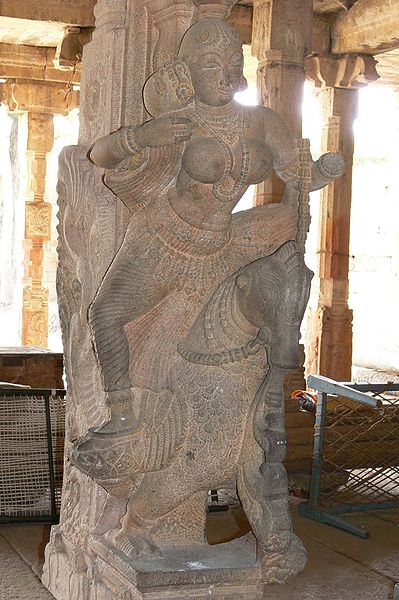
The artistic representations of Goddess Rati in these temples are a testament to her mythological significance. Sculptures and paintings often depict her in various postures of love and affection with Kamadeva. Symbolizing the different aspects of their divine relationship. Intricate carvings and artworks found in these temples not only serve as religious icons but also as cultural artifacts. Offering insights into the historical and artistic interpretations of Rati’s myths.
Festivals and Celebrations of Rati
Holi
The festival of Holi celebrated in India that falls usually in the month of March is also devoted to Rati and Kamadeva.
There are many legends associated with Holi. According to one legend, Kamadeva sacrificed himself for the good of the universe on the day of Holi. The traditional bonfire lit on the night before Holi thus also symbolizes the sacrifice of Kamadeva as he turned to ashes for the good of humanity.
Many people worship lord Kamadeva and Devi Rati on Holi with the offerings of a mixture of sandalwood paste and mango blossoms. It is believed that this paste will cool off the pain of Kamadeva’s burns. On Holi, some people also sing songs depicting the sorrow and pain of Goddess Rati when she got separated from Kamadeva, her husband and lover of eternity.
Holi is also the festival of love and bliss. It’s an occasion when all boundaries and hierarchies are broken as people embrace young and old, rich and poor, everyone alike the magic brush of Holi colors or gulal. The festival is thus symbolic of the eternal love of Goddess Rati and lord Kamadeva. The throwing of colors is a commemoration of the playful aspects of Rati and Kamadeva.
Vasant Panchami
Goddess Rati and Kamadeva are also associated with the onset of spring. Spring is considered the season of love in ancient Hindu scriptures. A lot of classical Sanskrit literature devoted fo love and romance celebrates the season of spring or vasant ritu.
It’s believed that it is during spring that Rati and Kamadeva shoot their love arrows at people. Creating conditions for the delights and bliss of love as flowers are blossoming and nature is at its glorious best.
The festival of Vasant Panchami is celebrated to honour the arrival of spring. Though Goddess Saraswati is the main deity worshipped on Vasant Panchami, Rati and Kamadeva are also worshipped on this day.
According to various beliefs, devotees need to chant the Rati Kamadeva Mantra 108 times after sunrise to sele the blessings of Devi Rati and lord Kamadeva. Many people conduct Kamadeva Rati Pooja following specific rituals on this day.
Worshipping the Goddess of Love along with her husband on this day is specially considered auspicious for married couples.
Rituals and Customs in Rati’s Festivals
The rituals and customs observed during these festivals are diverse, reflecting the regional variations in Rati’s worship. Common practices include the offering of flowers and sweets, singing of devotional songs, and recitation of prayers dedicated to Rati and Kamadeva. These rituals not only honor Rati but also reinforce the cultural significance of love and desire in human life, as depicted in her myths.
Symbols and Icons of Goddess Rati
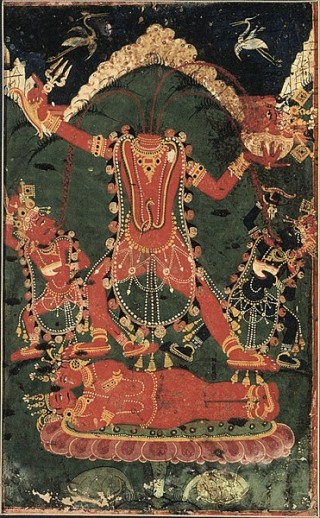
Colours
Red – symbolizes passion and intensity. The colour red is frequently used in rituals and artworks depicting Devi Rati.
Yellow – The colour yellow is associated with spring. Spring is the time when Goddess Rati and lord Kamadeva are believed to target the mortals with their love arrows. Thus, yellow colour is also associated with Devi Rati.
Flowers & Scents
Flowers of the Asoka tree, the blue lily, lotus, mango flower and the jasmine are associated with Goddess Rati. The scents of these flowers stimulate the senses, therefore these scents are associated with the Goddess of Love.
Other common symbols include the bow and arrow. They represent the piercing nature of love. Finally, the presence of bees, symbolizing the sweetness and allure of romantic affection.
Plants
Lotus – The lotus represents beauty and purity. Thus, it is often associated with the Goddess of Love. Lotus is also symbolic of the ability to thrive despite adverse circumstances, something that also symbolizes Devi Rati’s life trajectory.
Asoka Tree – The Asoka Tree is also associated with Devi Rati and Lord Kamadeva. The flowers of this tree symbolize fertility.
Animals
Parrot – Parrots are depicted as the vahana or the vehicle of Rati and Kamadeva. They are frequently depicted in all stories and artworks related to Goddess Rati. Parrots symbolize communication and the art of expression of love.
Reflection and Closing Thoughts
Lessons and Values Embodied by Devi Rati
Goddess Rati, through her myths and worship, teaches profound lessons about the nature of love and desire. Her stories remind us that true love is resilient, transcending trials and tribulations. Rati’s devotion to Kamadeva, even in the face of adversity, highlights the strength and purity of love. Her narratives encourage us to embrace love in its entirety, acknowledging both its joys and sorrows.
Embracing the Divine Connection
In reflecting upon Goddess Rati, we are invited to explore our own connections with the divine aspects of love. Rati’s tales and teachings offer a pathway to understanding the deeper spiritual significance of our emotions and relationships. Embrace the lessons of Rati. Open yourself to experience love in its most sublime and divine form, transcending the physical realm and touching the soul.
FAQs about Goddess Rati
Kamadeva, the God of Love is the eternal consort of Goddess Rati
She is worshipped during the festivals of Holi and Vasant Panchami.
Goddess Rati is the daughter of Daksha Prajapati
Goddess Rati and her husband Kamadeva spread love throughout the universe by shooting Gods and mortals alike with their love arrows.
Featured Image Credit: thesandiegomuseumofartcollection, Public domain, via Wikimedia Commons

